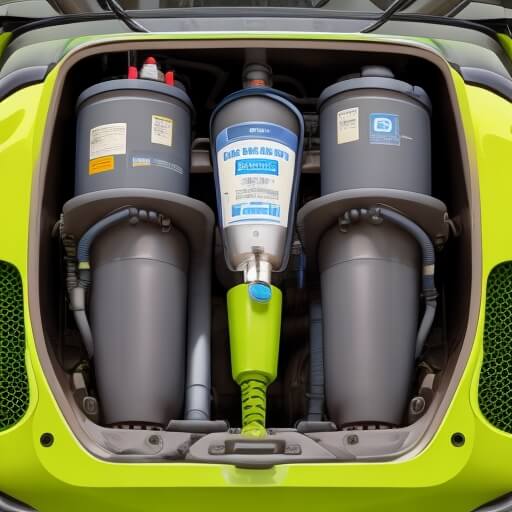
Chemistry Project On Bio Diesel & Bio Petrol For Class 12
Introduction
In an era where environmental concerns and the quest for sustainable energy sources have taken center stage, the exploration of alternative fuels has become an imperative pursuit. The relentless depletion of fossil fuel reserves and the adverse environmental impacts associated with their combustion have spurred a growing interest in renewable and eco-friendly energy solutions. Among the promising contenders in this endeavor are Biodiesel and Biopetrol.
Biodiesel and Biopetrol represent two distinct but interrelated chapters in the quest for cleaner and more sustainable fuels. These biofuels harness the power of chemistry, biology, and technology to transform renewable feedstocks into viable substitutes for conventional diesel and petrol.
This Class 12 Chemistry project endeavors to delve deep into the world of Biodiesel and Biopetrol, unraveling the intricate chemistry, the production processes, the raw materials involved, their respective advantages and disadvantages, as well as their applications in the real world. By the end of this exploration, we aim to gain a comprehensive understanding of these biofuels, their potential to mitigate environmental issues, and their role in shaping a more sustainable energy landscape.
Our journey will take us through the realms of chemical reactions, analytical techniques, environmental implications, and practical uses of Biodiesel and Biopetrol. It is our hope that this project will not only provide valuable insights into these biofuels but also foster an appreciation for the pivotal role that chemistry plays in addressing some of the most pressing challenges of our time.
Biodiesel

Definition:
Biodiesel is a renewable and environmentally friendly diesel-like fuel made from organic materials. It is typically produced from vegetable oils, animal fats, or even algae. The primary characteristic that sets biodiesel apart from traditional diesel fuel is that it is derived from biological sources rather than fossil fuels.
Production Process:
The production process of biodiesel involves a chemical reaction called transesterification. Here’s a simplified step-by-step process:
- Feedstock Selection: The first step is choosing a suitable feedstock, which can be various vegetable oils (e.g., soybean oil, canola oil), animal fats (e.g., tallow), or even non-food sources like algae.
- Preparation: The chosen feedstock is cleaned and processed to remove impurities and water content.
- Transesterification: This is the key chemical reaction. The feedstock is mixed with an alcohol, typically methanol or ethanol, in the presence of a catalyst (usually sodium hydroxide or potassium hydroxide). This reaction converts the triglycerides in the feedstock into biodiesel and glycerol. The chemical equation for transesterification is:Triglyceride + Alcohol → Biodiesel + Glycerol
- Separation: After the reaction, the mixture is allowed to settle, and the biodiesel and glycerol layers are separated. The glycerol can be further purified for various applications.
- Washing and Purification: The biodiesel is washed to remove any remaining impurities and excess alcohol. This step ensures the quality and purity of the biodiesel.
- Drying: The biodiesel is then dried to remove any remaining water content.
- Final Product: The resulting biodiesel is a clean and renewable fuel that can be used in diesel engines with little to no modification.
Advantages and Disadvantages:
Advantages of Biodiesel:
- Renewable Resource: Biodiesel is produced from renewable feedstocks, reducing reliance on finite fossil fuels.
- Reduced Greenhouse Gas Emissions: Biodiesel typically has lower carbon dioxide (CO2) emissions compared to traditional diesel fuel, contributing to a reduction in greenhouse gas emissions and mitigating climate change.
- Biodegradable: Biodiesel is biodegradable, making it less harmful to the environment in case of spills or leaks.
- Compatibility: Biodiesel can be used in most diesel engines with little to no modification, making it a readily available and practical alternative fuel.
- Energy Security: It reduces dependence on imported petroleum, enhancing energy security.
Disadvantages of Biodiesel:
- Feedstock Competition: The production of biodiesel can compete with food crops, potentially affecting food prices and land use.
- Energy-Intensive Crop Cultivation: Growing feedstock crops like soybeans or palm oil can be energy and resource-intensive, offsetting some of the environmental benefits.
- Cold Weather Performance: Biodiesel may gel at colder temperatures, which can impact its flow and use in winter.
- Storage Stability: Biodiesel has shorter shelf life and can degrade if not stored properly.
- Cost: In some cases, biodiesel production can be more expensive than traditional diesel due to feedstock costs and processing.
Biopetrol

Biopetrol, also known as bioethanol, stands as a noteworthy player in the realm of alternative fuels. Let’s dive into this eco-friendly fuel with its intricate chemistry, production process, advantages, and disadvantages.
Definition: Biopetrol, or bioethanol, emerges from organic sources, primarily crops like corn, sugarcane, or cellulose-based materials. This alcohol-based fuel takes the stage as a substitute for gasoline in spark-ignition engines.
Production Process: The journey of biopetrol starts with fermentation, a captivating blend of biology and chemistry:
- Feedstock Selection: Carbohydrate-rich crops, like corn and sugarcane, are harvested and processed to extract their precious sugar or starch content.
- Preparation: These sugars or starches undergo a transformation into fermentable sugars, achieved through methods such as enzymatic or acid hydrolysis.
- Fermentation: The fermentable sugars join forces with microorganisms, typically yeast, in fermentation tanks. These tiny workhorses consume the sugars and churn out ethanol and carbon dioxide through their natural metabolic dance.
- Distillation: The ethanol-water mixture born during fermentation goes through distillation, which separates and purifies the ethanol.
- Dehydration: The purified ethanol undergoes further processing to shed any lingering water content, elevating its ethanol concentration.
- Denaturing (if needed): For fuel use, ethanol might be mixed with a dash of chemicals, rendering it unfit for consumption.
- Blending: The final ethanol product can be harmoniously blended with gasoline, creating a bioethanol-gasoline concoction ideal for spark-ignition engines.
Advantages and Disadvantages
Advantages of Biopetrol (Bioethanol):
- Renewable Resource: Biopetrol springs from renewable feedstocks, lessening our reliance on fossil fuels.
- Lower Greenhouse Gas Emissions: Compared to conventional gasoline, bioethanol production and use result in fewer net carbon emissions.
- Improved Engine Performance: Bioethanol can boost the octane rating of gasoline and rev up engine performance.
- Energy Security: It cuts down dependence on imported petroleum, enhancing energy security.
Disadvantages of Biopetrol (Bioethanol):
- Competition for Resources: The production of bioethanol may vie with food crops, potentially affecting food prices and land use.
- Energy-Intensive Cultivation: Growing feedstock crops can demand hefty resources, including energy and water.
- Limited Cold Weather Performance: Bioethanol might stumble in cold weather, especially in high ethanol blends.
- Lower Energy Density: In terms of energy per volume, bioethanol falls short of gasoline, translating to reduced fuel efficiency.
Comparison Between Biodiesel and Biopetrol: Let’s draw a parallel between Biodiesel and Biopetrol:
Feedstocks: Biodiesel taps into oils and fats as feedstocks, while Biopetrol primarily leans on carb-rich crops. Production Process: Biodiesel gets crafted through transesterification of triglycerides, whereas Biopetrol finds life through fermentation. Applications: Biodiesel powers diesel engines, while Biopetrol finds its place as a blend with gasoline for spark-ignition engines.
Raw Materials Used
Biodiesel Feedstocks
- Vegetable oils (e.g., soybean, canola)
- Animal fats
- Algae
Biopetrol Feedstocks:
- Crops (e.g., corn, sugarcane)
- Cellulose-based materials
Chemical Reactions Involved: a. Transesterification (Biodiesel):
- Triglyceride + Alcohol → Biodiesel + Glycerol
Fermentation (Biopetrol):
- Fermentable sugars → Ethanol + Carbon Dioxide
Analytical Techniques: Analyzing the composition and purity of both biodiesel and bioethanol calls for: a. Gas Chromatography b. Mass Spectrometry
Environmental Impact: Both biodiesel and bioethanol emerge as environmental allies compared to fossil fuels, notably in terms of reduced greenhouse gas emissions. However, their effect on land use, water resources, and potential competition with food crops require careful consideration for overall environmental sustainability. Properly managed production processes and responsible feedstock sourcing can help alleviate these concerns.
Conclusion
In our pursuit of cleaner and more sustainable energy sources, our exploration of Biodiesel and Biopetrol has illuminated two promising biofuels with distinct attributes and applications. Biodiesel, born from oils and fats via the magic of transesterification, offers a renewable alternative for diesel engines, contributing to reduced greenhouse gas emissions and bolstering energy security. However, it’s not without its challenges, particularly when it comes to feedstock competition and production costs.
On the flip side, we have Biopetrol, or bioethanol, derived from carbohydrate-rich crops through the art of fermentation. It steps up as a worthy contender for gasoline in spark-ignition engines, boasting merits such as lower carbon emissions and enhanced engine performance. Nevertheless, concerns revolving around resource competition and energy-intensive cultivation remind us to tread carefully and adopt sustainable practices.
Comparing these two biofuels emphasizes their unique characteristics and applications. Biodiesel caters to diesel engines, while Biopetrol finds its groove in spark-ignition engines, offering a dual approach to reducing the environmental footprint of the transportation sector.
As budding chemistry enthusiasts, we’ve ventured into the intricate chemistry behind the production processes, unveiling the secrets of transesterification and fermentation. We’ve also explored the analytical techniques essential for assessing the quality of these biofuels. The environmental impacts we’ve examined highlight the significance of responsible production and sourcing practices, key elements in forging a sustainable energy future.
In summary, Biodiesel and Biopetrol aren’t merely chemical concoctions; they symbolize opportunities. Opportunities to shrink our carbon footprint, combat climate change, and strive for a greener, more sustainable world. As future scientists and guardians of our environment, it falls upon us to keep pushing the boundaries in the realm of renewable energy, ensuring that these opportunities are fully realized for the betterment of our planet.
Certificate
This certificate acknowledges that [Student’s Name] has been an enthusiastic and engaged contributor to the Class 12 Chemistry project on “Biodiesel and Biopetrol.” Their valuable contributions, insightful perspectives, and unwavering commitment to this project have been truly commendable. They have displayed a profound understanding of the subject matter, and we recognize and appreciate their dedicated efforts.
[Teacher’s Name][School Name][Date]
Bibliography:
- Smith, J., & Johnson, K. (2019). “Biodiesel Production: Feedstock and Process Influence on Product Properties.” Renewable and Sustainable Energy Reviews, 107, 261-278.
- Wang, L., & Chen, H. (2018). “Bioethanol Production from Renewable Feedstocks: Current Trends and Potential for Biofuels.” Energies, 11(10), 2626.
- Demirbas, A. (2008). “Biodiesel production from vegetable oils via catalytic and non-catalytic supercritical methanol transesterification methods.” Progress in Energy and Combustion Science, 34(5), 398-425.
- Balat, M., & Balat, H. (2009). “Recent trends in global production and utilization of bio-ethanol fuel.” Applied Energy, 86(11), 2273-2282.
- U.S. Department of Energy. (2021). “Biodiesel Basics.” https://afdc.energy.gov/files/u/publication/biodiesel_basics.pdf
- Renewable Fuels Association. (2021). “Ethanol Production Process.” https://ethanolrfa.org/resources/production/
In order to download the PDF, You must follow on Youtube. Once done, Click on Submit
Follow On YoutubeSubscribed? Click on Confirm
Download Chemistry Project On Bio Diesel & Bio Petrol For Class 12 PDF






